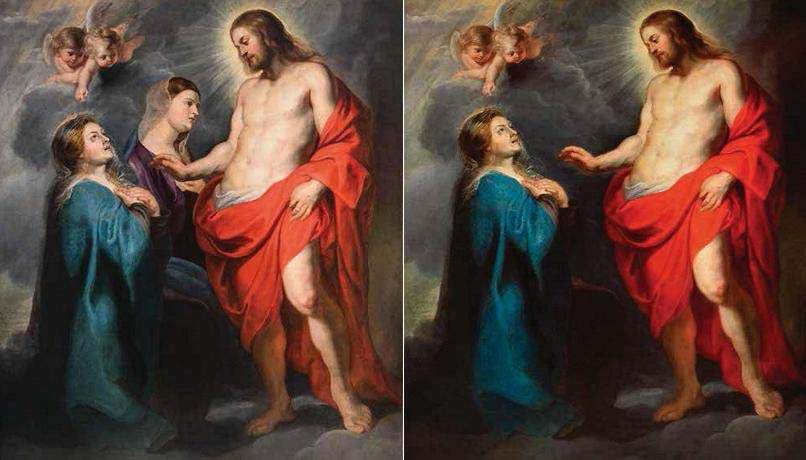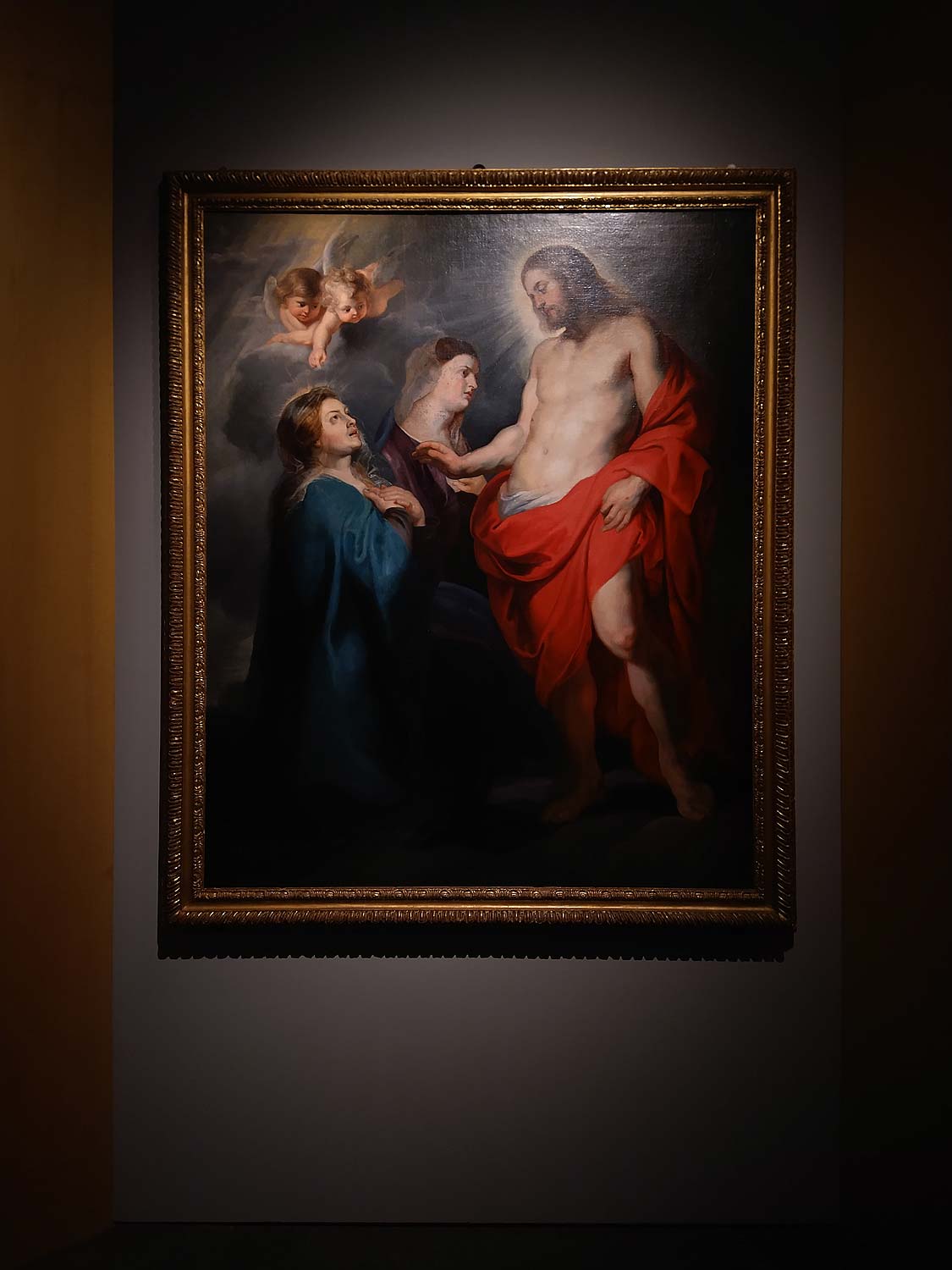What do we know so far about the painting seized from the Rubens in Genoa exhibition running until February 5, 2023 at the Palazzo Ducale in Genoa? In the meantime, some information about the painting: it is a resurrected Christ Appearing to His Mother, which is still being studied, and displayed at the exhibition with restoration work in progress, as Federico Giannini explained in his detailed review of the exhibition. It could be a painting mentioned as a work by Rubens in a 19th-century Genoese inventory, thought to be lost but known from 17th-century engravings, and recently rediscovered: it would not, however, be a work exclusively by Pieter Paul Rubens. More likely it is a workshop work on which the master later intervened, so much so that in the exhibition the painting is displayed as “Rubens and workshop.” It was initially painted with the Virgin much closer to Christ, in a “first state” that is, however, in compromised conservation condition, such that “attribution is difficult,” writes scholar Fiona Healy in the catalog, “although the apparently mechanical execution of the Madonna suggests the hand of an assistant.”
The “second state,” or the final, visible redaction of the painting, would be attributable to Rubens, according to Healy, in the interventions on the Virgin’s head and the angel standing further to the right. “Not to be excluded,” writes Federico Giannini in the review, “that the first state is a workshop replica of a lost original on which the master may later have intervened.” In the exhibition it is displayed with both faces of the Virgin uncovered: once the exhibition is over, it is highly likely that the face of the “first state” will be covered again. The catalog also reconstructs the recent history of the painting: until 1833 (and perhaps since 1818) the work was located at Palazzo Nicolò Grillo Cattaneo in Genoa, as a work by Rubens, and prior to 1919 it is attested in the properties of the noble Cambiaso family of Genoa, always cited as a canvas by “P. Paolo Rubens,” “Risen Jesus reappears to the Magdalene - Painting of grand lights, figures to the truth, drawn and draped with that majesty which distinguishes all the works of the great painter” (so it appears in a 1919 inventory). Remaining the property of the Cambiaso family until 2004, it is attested in the Centurione palace in Piazza Fossatello, after which it was purchased in 2012 by the current owner.


And it is precisely on the recent passages that the Genoa Public Prosecutor’s Office is focusing its investigation, with allegations of illegal export of cultural goods and self-laundering against four suspects, two art dealers, an accountant and his son. The investigation is coordinated by prosecutor Eugenia Menichetti and deputy prosecutor Paolo D’Ovidio: according to investigators, the heirs of the Cambiaso family, knowing that in the old inventories the work was assigned to Rubens, had tried to sell it but failed. They had then sold it in 2012 to the two antiquarians under investigation, for the sum of 350,000 euros: the latter had then had it restored in 2014 in Florence, and on that occasion the first draft of the painting would have emerged. The same ones would then have the work from Italy released by submitting an application for export authorization in which the painting was passed off as a work of the Flemish school, with a value of 25 thousand euros, in order to facilitate the exit. And this, according to investigators, when the dealers already knew that the painting had a Rubens attribution. The export office in Pisa, to which the request was submitted, granted the certificate of free circulation, which was issued, the Carabinieri of the Nucleo Tutela Patrimonio Culturale who implemented the seizure know in a note, as a result of “false statements and omissions” by the suspects.After the painting left Italy, its owners allegedly decided to lend it to the exhibition at the Doge’s Palace, the investigators know, in order to raise the painting’s prices: the work, on which the historical-critical debate is indeed ongoing, was secured for four million euros, a value of ten times the price at which it was sold in 2012. Moreover, to disguise the sale in order to hinder its identification, again according to prosecutors, the two antiquarians set up, with the help of the accountant under investigation, a number of companies with offices abroad. It is not known from where the prosecutor’s investigation was triggered, but paradoxically the exhibition loan may have been decisive: without the attention around the painting, perhaps the affair would not have emerged.
The good news for the Palazzo Ducale is that the Genoese museum and the two curators of the exhibition, Nils Büttner and Anna Orlando, are totally uninvolved in the affair and no charges have been brought against them. “The painting,” the Ducal Palace said in a note, “was positioned outside the main itinerary of the exhibition [ed. note: it was, in fact, an appendix section, at the end of the tour route], which therefore remains visitable without losing its value as an artistic testimony of an exceptional historical period for the city of Genoa. Director Serena Bertolucci confirms the full and absolute collaboration between Palazzo Ducale Fondazione per la Cultura and the Carabinieri of the Cultural Heritage Protection Unit.”
The restoration work currently underway is being carried out by KIK-IRPA, Koninklijk Instituut voor het Kunstpatrimonium-Institut royal du Patrimoine artistique (Royal Institute of Artistic Heritage), Belgium’s highest authority on cultural heritage. Orlando, in a statement released to the newspaper Genova24, confirmed that the painting was submitted to the scientific community just in recent years, some time after its sale in 2012, and that the decision to exhibit it was made after a study day held in Brussels in August this year and dedicated precisely to the now seized painting. Although the affair may be reminiscent of that of the Modigliani forgeries also seized at the Doge’s Palace in 2017, this is actually a profoundly different case, since the goodness of the painting, in this case, is not in question. As the president of the Region of Liguria as well as councillor for culture, Giovanni Toti, also recalled in a note, the seizure “is a measure that concerns the ownership of the painting and not its authenticity. Both Palazzo Ducale and the curators of the exhibition, with whom we have had the opportunity to deal, have operated in full compliance with the rules. We hope that there will be clarity on this matter soon and that the work will be able to be exhibited again as soon as possible. Above all, we hope that this investigation will not compromise the prestige of an important exhibition, which is having great success with the public, so much so that it has been extended until February 5.”
 |
| What we know about the seized Rubens. Estranged curators and museum, the position of the Ducal Palace |
Warning: the translation into English of the original Italian article was created using automatic tools. We undertake to review all articles, but we do not guarantee the total absence of inaccuracies in the translation due to the program. You can find the original by clicking on the ITA button. If you find any mistake,please contact us.